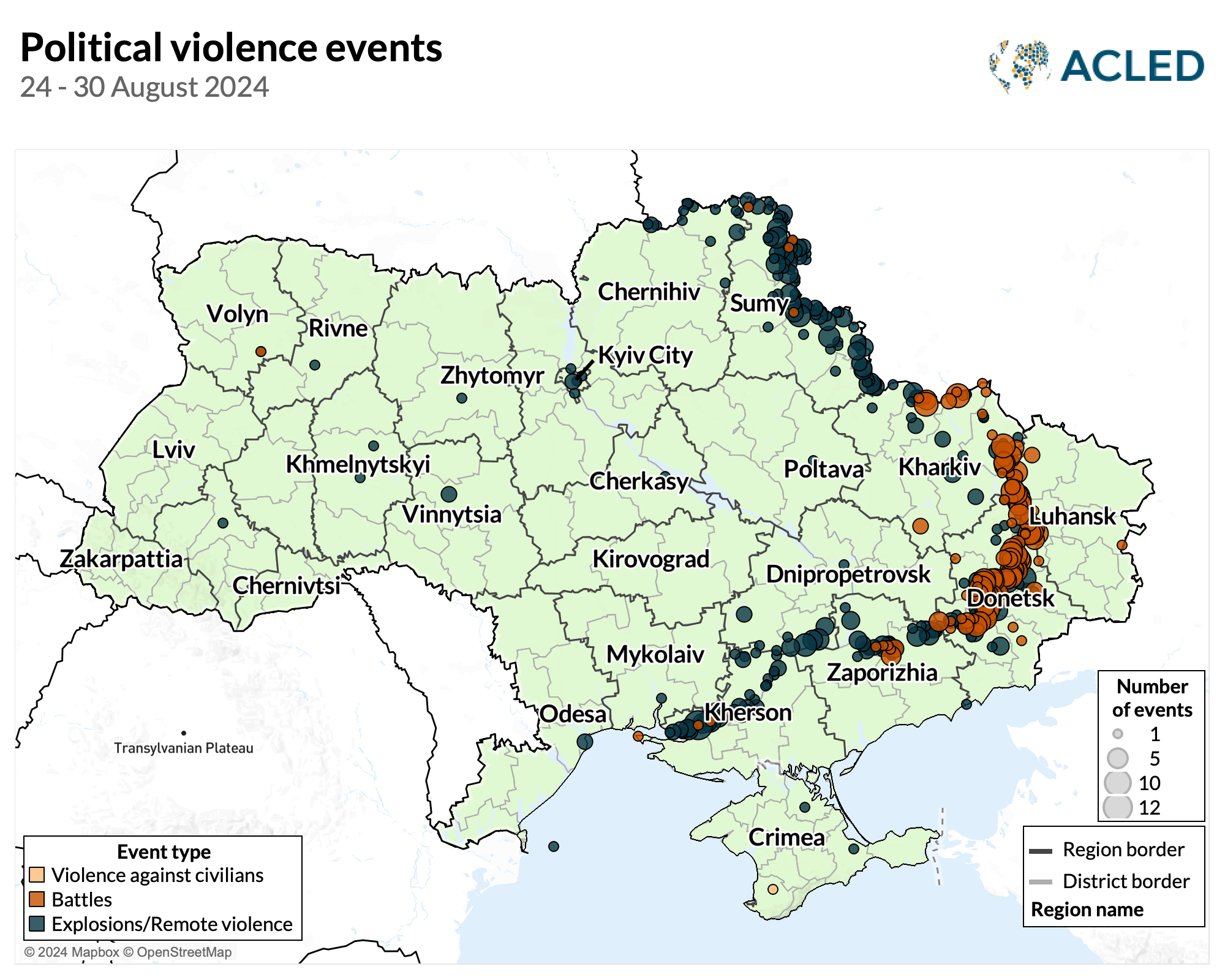For more information, including previous situation summaries and an interactive dashboard, visit our Ukraine Conflict Monitor.

Situation Summary
In the fourth week of their incursion in Russia’s Kursk region, Ukrainian forces adopted a more defensive posture to preserve their territorial gains while continuing to target Russian supply lines and pushing out Russian military units in the Korenevskyi, Glushkovskyi, and Sudzhanskyi districts. Meanwhile, Russian forces reported repelling a Ukrainian attack in the Belgorod region.
In Ukraine, intense fighting continued in the east, mainly in the Donetsk region, with Russian forces advancing towards the key city of Pokrovsk and occupying 10 settlements along its southeastern flank. Further north, Russian forces also seized Pivnichne on the eastern outskirts of Toretsk. Meanwhile, the number of clashes and shelling events continued to decrease in the Zaporizhia region, possibly due to Russian redeployments to the Kursk region.1Kateryna Denisova, ‘Russia redeploys 30,000 troops to Kursk Oblast amid Ukraine’s incursion, Syrskyi says,’ Kyiv Independent, 27 August 2024 In the Sumy region, the number of Russian shelling and air strikes increased slightly in comparison to the week prior.
On 26 and 27 August, Russia launched a massive wave of drone and missile strikes on 19 regions in Ukraine, targeting critical energy infrastructure and residential areas, including in Western Ukraine and Kyiv city. The strikes led to emergency power outages in several regions and disruptions in water supply.2Yulia Kuzmenko, ‘Ukraine’s energy system remained intact after the August 26 strikes – Ministry of Energy,’ Suspilne Media, 29 August 2024 In the Kyiv region, Russian missiles and drones reportedly hit the Kyiv Hydroelectric Power Plant for the first time, which holds a large water reservoir upstream from the capital. The strikes caused damage to the facility but not its dam.3Artur Kryzhnyi, ‘Russians hit Kyiv Hydroelectric Power Plant, damage reported,’ Ukrainska Pravda, 26 August 2024 The strikes killed over 50 civilians in the Donetsk, Kharkiv, Sumy, Kherson, Dnipropetrovsk, Zaporizhia, Odesa, Zhytomyr, and Volyn regions. On 24 August, a Russian missile hit a hotel in Kramatorsk, Donetsk region, killing a Reuters security adviser and wounding five journalists from Ukraine, the United States, Lithuania, Poland, and Germany, along with two Ukrainian civilians. On 30 August, a Russian aircraft struck the city of Kharkiv with guided aerial bombs, hitting a residential building, a high school, and a children’s playground. At least seven people were killed and 97 wounded, including 22 children.
Russian attacks also affected Belarus, where, throughout the week, at least eight Russian drones violated the Belarusian airspace in the districts adjacent to the Belarus-Ukraine international border. It is not clear whether the continuing overflights are due to drone malfunction or the result of Ukrainian signal interference, yet Belarusian air force and air defense were activated to intercept the drones on several occasions throughout the week.4Valentyna Romanenko, ‘Belarus uses aircraft to down Russian attack drone that flew into Belarus for first time,’ Ukrainska Pravda, 29 August 2024




